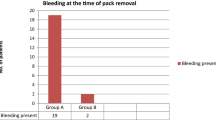Abstract
Endoscopic septoplasty has advantage of magnified image and access to posterior part of the septum. Synechiae formation is a common complication of this procedure. The incidence of adhesions rises particularly in cases of submucosal flap tears which is sometimes unavoidable during spurectomy. Various procedures like septal splints, nasal packings have been tried to reduce the incidence of adhesions. Recently mitomycin-C is being tried to decrease post operative adhesions after Functional Endoscopic Sinus Surgery, endoscopic Dacrocystorhinostomy, with varying degree of success. Mitomycin-C has got anti fibroblastic activity, which inhibits the fibroblasts without hampering epithelization. Eighty (80) Patients undergoing septoplasty and spurectomy were observed for any submucosal flap tear, and those developing flap tear were included in the study. The patients were divided into 2 groups of 40 each. In group-1 topical mitomycin (0.4 mg/ml) was applied at the raw area for 5 min, similarly normal saline was applied in group-2 (control).The aim of study was to evaluate the role of mitomycin-C in preventing post operative adhesions in Endoscopic septoplasty. Adhesion rate was calculated at 1 month, and compared using Chi square test. P value < 0.05 was considered significant. The adhesion rate at 1 month was 17.5% in group-1 and 45% in group-2 (P = 0.008). Incidence of adhesion decreased significantly in mitomycin-C treated group. Mitomycin-C can routinely be used in septoplasty to prevent post op adhesions, particularly in cases of submucosal flap tears/concurrent turbinate reduction procedures.

Similar content being viewed by others
References
American Academy of Otolaryngology (2009) Fact Sheet: Deviated Septum. 04 Feb 2009
Alpini D, Corti A, Brusa E et al (1986) Septal deviation in newborn infants. Int J Pediatr Otorhinolaryngol 11:103–107
Hamid OA (1990) Deviated Nasal Septum in Saudi Newborns. Ann Saud Med 10(3):293–295
Cottle MH, Fischer GG, Loring RM, et al (1956) Early nasal injuries. Presented at the Meeting of the American Medical Association. (Cited in: Jazbi B (1977) Subluxation of the nasal septum in the newborn: etiology, diagnosis, treatment. Otolaryngol Clin North Am 10:125–36)
Abhinandan Bhattacharjee S, Uddin PP (2005) Deviated nasal septum in the newborn—A 1-year study.Indian Journal of. Otolaryngol Head Neck Surg 57(4):304–308
Goyal P, Hwang PH (2012) Rhinology: diseases of the nose, sinuses, and skull base, Ch 34. In: Surgery of the septum and turbinates Thieme publications, pp 444–456
Shone GR, Clegg RT (1987) Nasal adhesions. J Laryngol Otol 101:555–557
White A, Murray JA (1988) Intranasal adhesions formation following surgery for chronic nasal obstruction. Clin Otholaryngol 13:139–143
Junior RGC et al (2008) Frequency of nasal synechia after septoplasty with turbinectomy with or without the use of nasal splints. Int Arch Otorhinolaryngol 12:124–127
Rahbar R, Shapshay SM, Healy GB (2001) Mitomycin: effects on laryngeal and tracheal stenosis, benefits and complications. Ann Oto Rhino Laryngo 110:1–6
Lee DA (1994) Antifibrosis agent in glaucoma surgery. Invest Ophthalmol Vis Sci 35:3789–3791
Rohail A, Khan AA, Shafi A, Zia R, Akram S (2015) Frequency of intranasal adhesion in septoplasty without putting nasal splints. PJMHS 9(2):498
Jain L, Jain M, Chouhan AN, Harshwardhan R (2011) Conventional septoplasty verses endoscopic septoplasty: a comparative study. Peoples J Sci Re 4:24–28
Bothra R, Mathur NN (2009) Comparative evaluation of conventional versus endoscopic septoplasty for limited septal deviation and spur. J Laryngol Otol 123:737–741
Pringle MB (1992) The use of intra-nasal splints: a consultant survey. UK Clin Otolaryngol Allied Sci 17(6):535–539
Harugop AS, Mudhol R, Nargund A, Hugar S, Kapoor A, Shetty R (2014) Efficacy of Mitomycin-C for prevention of adhesion formation after functional endoscopic sinus surgery in cases of chronic rhinosinusitis: a prospective cross-sectional study. Clin Rhinol An Int J 7(3):100–104
Wellington YY, Luuis C (2012) The use of mitomycin-C to reduce synechia in middle meatus in sinus surgery: preliminary results. Braz J Otorhinolaryngol 78(5):44–50
Vaidyanathan V, Balasubramanian D, Suria Gopalakrishnan S, Saxena SK, Shanmugasundaram N (2012) Topical Mitomycin C in functional endoscopic sinus surgery. Eur Arch Otorhinolaryngol 269:1791–1794. https://doi.org/10.1007/s00405-011-1870-x
Tilakraj S, Himani L, Natesh V (2011) Role of Mitomycin-C in prevention of post operative adhesions after endoscopic sinus surgery—a prospective study. Indian J Otolaryngol Head Neck Surg 63(3):249–254. https://doi.org/10.1007/s12070-011-0145-6
Chung JH, Cosenza MJ, Rahbar R et al (2002) Mitomycin C for the prevention of adhesion formation after endoscopic sinus surgery: a randomized, controlled study. Otolaryngol Head Neck Surg 126:468–474
Gupta V, Singh I, Dwivedi G, Goyal S, Kumar M, Sood A et al (2018) A comparative study in the use of topical mitomycin-C versus nasolacrimal stent in endoscopic dacryocystorhinostomy for chronic dacryocystitis. Int J Otorhinolaryngol Head Neck Surg 4:176–184
Farooq MU, Ansari MA, Khyani IAM (2013) Role of mitomycin-c in endoscopic management of nasolacrimal duct obstruction. J Dow Univ Health Sci Karachi 7(2):63–67
Harugop AS, Rekha BK, Mudhol RS, Zingade ND, Hugar SM, Das AT, Maheswaran M (2013) Randomized placebo controlled trial of Mitomycin-C in surgical outcome of primary endoscopic dacryocystorhinostomy. Al Ameen J Med Sci 6(3):231–236
Jain NK, Vashistha S, Kaushik S (2013) Comparative study of endonasal endoscopic dacryorhinostomy with or without intraoperative Mitomycin C. Clin Rhinol: Int J 6(2):77–79
Author information
Authors and Affiliations
Corresponding author
Ethics declarations
Conflict of interest
All authors declare that they have no conflict of interest.
Rights and permissions
About this article
Cite this article
Sayeed, A., Alam, M., Sharma, S.C. et al. Mitomycin-C in Post-endoscopic Septoplasty Synechiae: Does it Really Helps?. Indian J Otolaryngol Head Neck Surg 71 (Suppl 3), 2091–2095 (2019). https://doi.org/10.1007/s12070-018-1496-z
Received:
Accepted:
Published:
Issue Date:
DOI: https://doi.org/10.1007/s12070-018-1496-z




